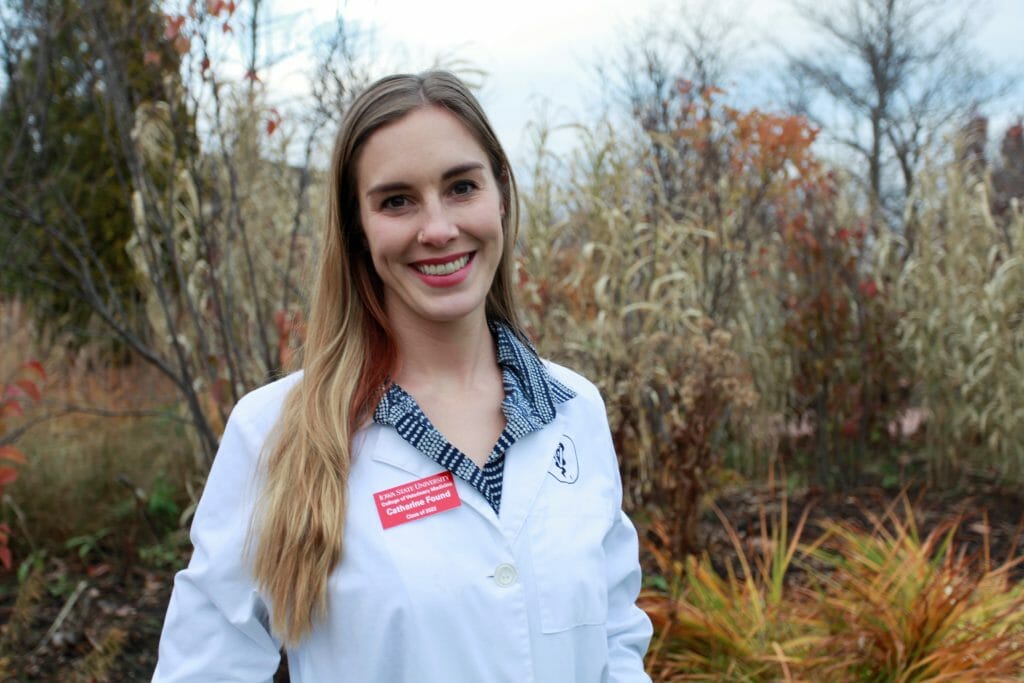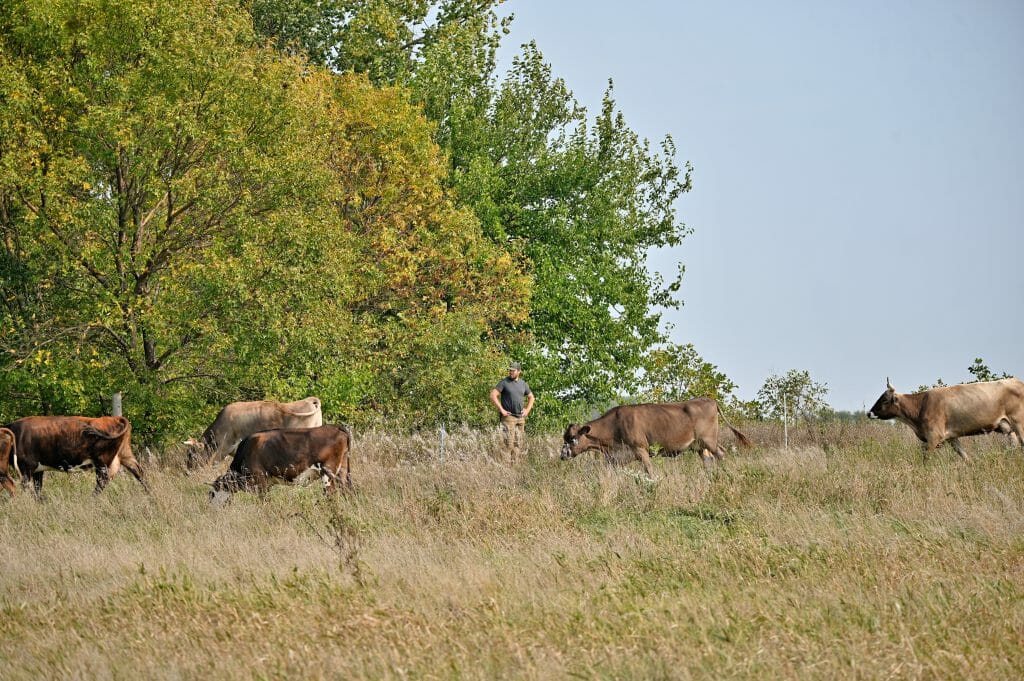A Keystone of Rural Vitality
A student’s research shows how grazing livestock benefit farmers and the land.
Catharine Found spent her spring 2021 semester researching a phrase Practical Farmers of Iowa attributes to co-founder Dick Thompson: “When livestock leave the farm, the people leave and the community begins to crumble.”
Catharine is a PFI member and third-year veterinary student at Iowa State University who is also pursuing her master’s degree at the University of Iowa College of Public Health. In early 2021, she reached out to PFI to express her interest in working on a project as part of the culmination of her master’s degree work, and wondered if there could be a way to link her public health studies with the needs of PFI staff. Catharine’s inquiry came around the same time that PFI released its feature-length film “Livestock on the Land,” in January. Catharine viewed the film during its premiere and was thrilled by it.

Catharine Found is a third-year veterinary student at Iowa State University who is also pursuing her master’s degree at University of Iowa’s College of Public Health.
The film – which explores how farmers are building resilient farms and communities by centering their operations around the animals they care for – inspired the focus of the project she undertook with PFI. Working with guidance from PFI’s livestock program manager, Meghan Filbert, Catharine examined existing research on regenerative livestock practices from a public health lens and – looking at Dick Thompson’s statement from a different angle – sought to answer the question: What do grazing-based farming practices mean for farmer well-being and the vitality of rural communities?
Catharine’s project connected her to the work of scientific leaders in the field. “I got to sit down with books that I don’t think I would have ever come across otherwise,” Catharine says. Books she read as part of her project include: “Agri-Food and Rural Development: Sustainable Place-Making” by Terry Marsden; “Hollowing Out the Middle: The Rural Brain Drain and What It Means for America,” by Patrick Carr and Maria Kefalas; and “Grasslands: Quietness and Strength for a New American Agriculture,” edited by Walter F. Wedin and Steven L. Fales.

Kevin Dietzel and his family raise grass-fed cattle and operate a cheesery at Lost Lake Farm near Jewell, Iowa.
The capstone of Catharine’s project was the publication of an annotated bibliography, posted on PFI’s website, evaluating peer-reviewed articles, socio-economic impact analyses and books. Catharine also learned from pertinent podcasts, webinars and PFI’s annual conference, as well as through discussions with research leaders in Iowa, including staff at University of Northern Iowa’s Center for Energy and Environmental Education, University of Iowa’s Center for Agricultural Safety and Health and the Leopold Center for Sustainable Agriculture.
Project Findings
Catharine explains that exploring how communities are affected when livestock leave the farm initially seemed like a practical endeavor, given that livestock management has evolved alongside humans for thousands of years. But she discovered that almost every article she read referenced the lack of research on regenerative agriculture and rural integrity practices in relation to human well-being. “It became frustrating to not encounter literature that directly broached this subject,” Catharine says. “But it also sets the precedent for researchers in the agricultural sector. There is a hole we must work towards filling.”
Despite the relative paucity of relevant literature, Catharine did find some pertinent study results. Combined with her other reading and research, she found that grazing and regenerative agriculture practices are linked with a host of benefits to both farmers and the land. Among her findings:
- Regenerative agriculture mimics rather than dominates nature. It repairs the soil and has the ability to increase farmers’ income stability.
- Regenerative-based livestock practices have the ability to increase farmers’ income stability, while increasing the proportion of middle-class families in rural areas.
- The best species to graze marginal lands, often those unsuitable for crops, are ruminant livestock above any other species.
- Farmers who are strongly committed to local food markets attach greater importance to civic engagement.
- Grazing-based practices give farmers a renewed sense of stewardship of the land. Farmers who understand soil quality and ecosystem services undergo a shift in ethics and rediscover what it means to sustain a farm for generations to come.
- Regenerative grazing techniques allow for diversification of on-farm funds, diversity of workday tasks and overall improved farmer satisfaction.
- Public health is improved through our grazing-based livestock systems. These systems can mitigate climate change by keeping carbon in the ground and reducing greenhouse gas emissions.
- Grazing-based livestock systems reduce the need to use drugs that kill parasites (called anthelmintics) and antibiotics in animals, both of which have known impacts on human health.
- Grazing-based systems improve soil quality and dramatically decrease runoff into our water sources.
Catharine’s research also revealed some of the challenges to adopting regenerative grazing practices. “Most references comment on the need for more research on how to properly implement regenerative strategies, keeping in mind that strategy is highly dependent on geography, soil and management,” she says. “Quantifying profits from switching to regenerative grazing is heavily related to location and landscape management. Yet farmers need to quantify profit margins before making the switch.”
Solutions
The second part of Catharine’s project involved brainstorming some ways to prevent the disintegration and rural decline that follows when livestock leave. The solutions she highlighted range from actions at the federal level to ongoing work that individuals and groups like PFI can continue to do. She notes:
- As outlined in the U.S. farm bill, current federal and farm subsidies skew much more heavily toward supporting commodity production, without incentivizing regenerative agriculture practices. To improve assistance to farmers implementing regenerative practices, federal and state programs need to tailor their funding and consultation toward these interests.
- Continue education efforts that can help encourage a change in the mindsets of federal and state granting organizations and farmers in the PFI region, such as community pasture walks and local hands-on demonstrations.
- Invest in educating younger generations about regenerative grazing based practices, including through National FFA Organization and 4-H.
- PFI should continue to freely share educational materials with prospective regenerative farmers. This could include input and output cost parameters, recommended seed varieties and pertinent native plant species for grazing.
Through her master’s project experience, Catharine was able to take a closer look at how our modern livestock practices influence our communities and public health. She learned that mainstream audiences increasingly understand and accept what’s involved with sustainable and regenerative agriculture, which opens the door to greater understanding about how those systems relate to community development.
“As a future veterinarian and public health practitioner, what I learned during this experience has had an incredible impact on my career outlook,” she says. “I plan to take this experience with me when I practice veterinary medicine in Iowa.”
